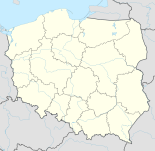Przygórze
| Przygórze | ||
|---|---|---|
 Help on coat of arms |
|
|
| Basic data | ||
| State : | Poland | |
| Voivodeship : | Lower Silesia | |
| Powiat : | Kłodzki | |
| Gmina : | Nowa Ruda | |
| Geographic location : | 50 ° 36 ' N , 16 ° 33' E | |
| Height : | 480 m npm | |
| Residents : | 860 | |
| Postal code : | 57-441 | |
| Telephone code : | (+48) 74 | |
| License plate : | DKL | |
| Economy and Transport | ||
| Next international airport : | Wroclaw | |
Przygórze (German: Köpprich - hamlet (colony) of the municipality of Volpersdorf , not: Koppernick ) is a district of the rural municipality of Nowa Ruda ( Neurode ) in the Lower Silesian Voivodeship in Poland . It is located at the foot of the western foothills of the Owl Mountains , 21 kilometers northwest of the district town of Kłodzko ( Glatz ), and 66 kilometers southwest of Wroclaw . The place was first bought and mentioned as Köpprich in 1721. In 1789 there were 11 cottages and there were 42 inhabitants in 1818.
On the origin of the Koppernigk family
Leopold Prowe and Maximilian Curtze suspect that Nicolaus Copernicus' ancestors came from the former Köpprich and not from Kopernik near Neisse. They are based on an essay by Augustin Knötel, which Georg Bender confronts conclusively by first eliminating the possibility that the hamlet of Köpprich could be the place of origin and then explaining the reasons for which Köppernig in Nysa is to be regarded as the place of origin of the Koppernigk family . On the basis of Bender's essay, this assumption is recognized today. In addition to the late first mention of the place, he bases his presentation on an onomastic derivation. He posed the contradiction between Knötel's assertion that, according to local tradition, Köpprich is actually called Köppernick and his testimony to the contrary, that the majority of the name is popularly the Köpprige . If this assumption is correct, its complete derivation from the German word Kupfer could actually take place because of the missing letter n , but not a derivation to the family name Koppernigk, which, even if it would otherwise be spelled differently when it occurs frequently in different places, always means that n would be kept in the final syllable. In addition, neither in Köpprich nor in Köppernig are there any evidence of old copper mining, making Knötel's attempt to construct a Polish-German mixed word Kupfernik for copper graves impossible.
literature
- Georg Bender: Home and folklore of the Koppernigk family (Coppernicus). Attachment: Dr. Woiciech Ketrzynskis Evidence for Polishism in Medieval Thorn. Ferdinand Hirt, Breslau 1920 (representations and sources on Silesian history, 27)
- Leopold Prowe: Nicolaus Coppernicus. 2 volumes. Weidmann, Berlin 1883/84.
- Maximilian Curtze in: Nicolaus Coppernicus from Thorn on the circular motions of the cosmic bodies. E. Lambeck, Thorn 1879.
- Augustin Knötel: The Silesian descent of Nikolaus Kopernicus. In: Rübezahl. [formerly Schlesische Provinzialblätter], 1873 p. 285 ff.
Web links
Individual evidence
- ↑ a b c Georg Bender: Homeland and folklore of the Koppernigk family. P. 4 f.
- ↑ 1. Documents in which the name Koppernigk appears in any form are not exactly rare before the astronomer was born; however, not all refer to ancestors of the same. The first members of the Thorner Koppernigk family, which can be traced back to Thorn as early as 1400, come from the village of Koppernick (now Köpprich) near Frankenstein in the County of Glatz; its later members, especially the astronomer's father, immigrated to Thorn from Cracow. The probability cannot be denied that these Koppernigk's are related to those who first immigrated to Thorn (around 1400) and that they also immigrated from Frankenstein to Krakow. Those Copirnik's that come from the village of Kopernik near Neisse do not appear at all written with a double-p. - Maximilian Curtze , in Nicolaus Coppernicus from Thorn on the circular movements of the world . Thorn: E. Lambeck, 1879 online
- ^ Augustin Knötel: The Silesian descent of Nikolaus Kopernicus.
